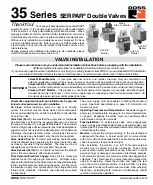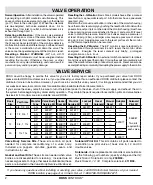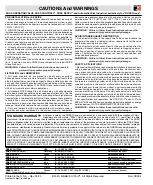
35
Series
SERPAR
®
Double Valves
Thank You!
You have purchased a premium-quality ROSS
®
pneumatic valve. It is a double valve designed to offer added safety
to the operation of many pneumatically controlled machines. When
properly installed, it conforms with the OSHA standards for control of air
clutch/brake mechanisms used on certain mechanical power presses.
With care in its installation and maintenance you can expect it to have
a long and reliable service life. Before you go any further, please take
a few minutes to look over the information in this folder, and save it for
future reference.
Service manuals with additional information are also available, please
visit ROSS' website at www.rosscontrols.com.
Pneumatic equipment should be installed only by persons
trained and experienced in such installation.
Air Lines:
Before installing a valve in a new or an existing
system, the air lines must be blown clean of all contaminants.
It is recommended that an air filter be installed in the inlet line
close to the valve.
Valve Inlet (Port 1):
Be sure that the supply line is of adequate
size and does not restrict the air supply because of a crimp in
the line, a sharp bend, or a clogged filter element. The air supply
must not only provide sufficient pressure (see
Valve Specifications,
page 3),
but must also provide an adequate flow of air on demand.
Otherwise, the valve elements will be momentarily starved for
air and the valve may be locked out by the monitoring system.
Valve Outlet (Port 2):
For faster pressurizing and exhausting
of the mechanism being operated by the valve, locate the valve
as close as possible to the mechanism. The lines must be of
adequate size and be free of crimps and sharp bends.
Valve Exhaust (Port 3):
Do not restrict air flow from the exhaust
port as this can adversely affect valve operation.
Pilot Solenoid Electrical Supply:
Basic Size 4 valves get
electrical power through plug-in connectors. All larger valves
have an internal terminal strip which must be connected according
to the circuit diagram accompanying the valve. In either case,
the electrical supply must correspond to the voltage and hertz
ratings of the solenoids. Otherwise, the solenoids are subject
to early failure.
The power supply must be capable of handling the maximum
power. See
Valve Specifications
on page 3 for information on
maximum power.
Operating Pressures and Temperatures:
Allowable ranges for
pressure and temperature are given in the
Valve Specifications
on page 3. Exceeding the values shown can adversely affect
performance and shorten valve life.
Pipe Installation:
To install pipe in valve ports, engage pipe
one turn, apply pipe thread sealant (tape not recommended), and
tighten pipe. This procedure will prevent sealant from entering and
contaminating the valve.
Monitor:
Connect the wiring according to the circuit diagram
supplied with the valve. A lockout signal port (on valve models
with L-G monitor) can be connected to a normally closed pressure
switch to operate a lockout indicator light.
After installation, the monitor (L-G, E-P, D-S and/or external
monitor) must be tested for proper functioning. Take normal
press operation safety precautions during these tests to avoid
personal injury or damage to equipment. Electrically energize
both solenoids; depress one manual override; de-energize both
solenoids. This should result in a valve lockout and prevent the
valve from operating. Reset the monitor, and repeat the test
using the second manual override. Contact ROSS for testing
procedures for valves without manual overrides. After satisfying
these tests, energizing both solenoids simultaneously should
result in normal valve operation.
Valves Without Monitor
–
If your valve does not have its own monitor, the valve must be connected to an
external monitoring system, which ensures that press operation will be inhibited in the event of a malfunction.
Valves with E-P, L-G, or D-S Monitor
– Both solenoids must be de-energized before resetting the monitor. Otherwise,
the press or other mechanism can cycle immediately, and could result in personal injury and/or property damage.
Valves with E-P Monitor
– This product is a dual input device which requires two separate and distinct inputs.
Connect inputs only to terminals 1, 3 & 5. Using a single input or connecting an input to a terminal other than 1, 3 &
5 could result in personal injury and/or property damage.
with E-P
Monitor
with L-G
Monitor
WARNINGS:
Size 4
with L-G Monitor
VALVE INSTALLATION
with D-S
Monitor
ROSS
CONTROLS
®
www.rosscontrols.com
Please read and make sure you understand all installation instructions before proceeding with the installation.
Additional technical documentation is available for download at www.rosscontrols.com.
If you have any questions about installation or servicing your valve, please contact ROSS or your authorized ROSS distributor,
see contact information listed at the back of this document, or visit www.rosscontrols.com to find your distributor.






















